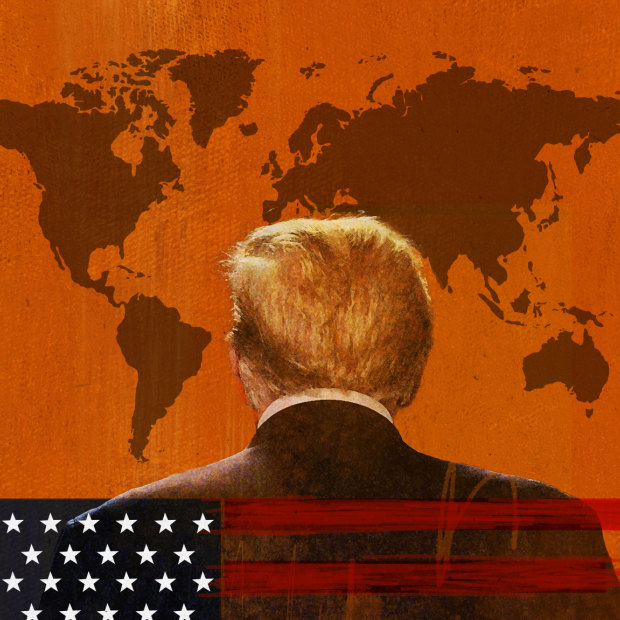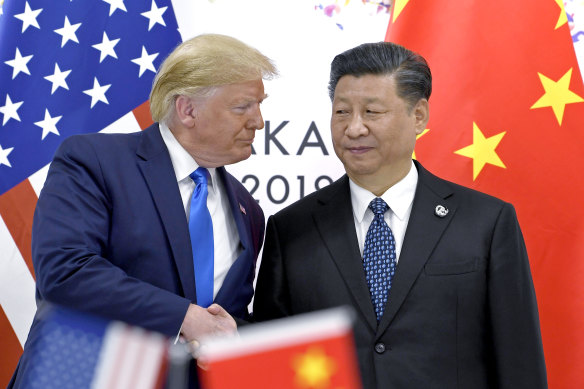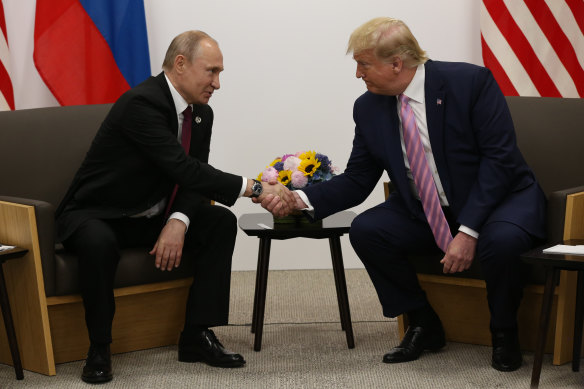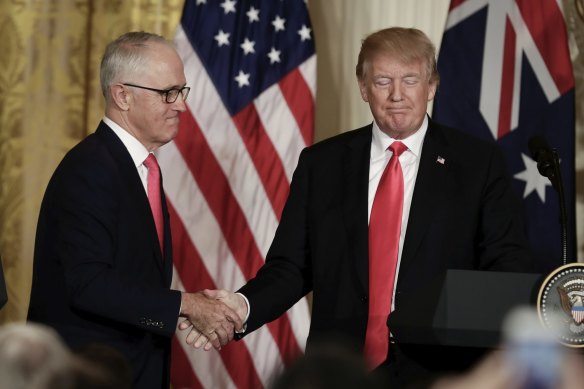This was published 1 year ago
Trump 2.0: What four more years mean for Australia and the world
In the first of a five-part series, international editor Peter Hartcher examines why Donald Trump is more inclined to like a US enemy than a friend.

At his core, Trump is transactional in dealings with world leaders.Credit: Artwork: Matthew Absalom-Wong
US Republicans traditionally put high value on relationships with America’s allies, but what exactly is an ally, and how do you differentiate between an ally and a mere friend?
One former senior official liked to put it this way: “We die for our allies; we like our friends.” This was the stark distinction drawn by Rich Armitage, a Republican and former US deputy secretary of state.
Donald Trump has a very different idea of US commitment to allies: “I’ve been saying, ‘Look, if they’re not going to pay, we’re not going to protect, OK?’ ” he said in February, speaking of the US allies in NATO.
Not only would he refuse to protect an ally who hasn’t “paid”, he’s said he’d actually encourage an enemy to do it harm. If Russia were to attack such an ally, said Trump, “I would encourage them [the Russians] to do whatever the hell they want”.
So on these definitions, a traditional Republican is prepared to die for a US ally, while a MAGA Republican is prepared to sacrifice one. This is a profound difference, one with potential to transform the world order.

Donald Trump’s admiration for Chinese President Xi Jinping is well known.Credit: AP
One of the defining differences between the US and its most formidable rival, China, is that America is the centrepiece of a constellation of some 40 allied nations, including all the most important rich nations on Earth.
By contrast, China has one treaty ally, North Korea, which it despises, and a few ragtag satrapies that are not so much allies as clients: Pakistan, Cambodia and Laos.
As a Chinese government official put it to an American interlocutor a few years ago: “You got the good ones [allies].”
China and Russia signed a so-called “no-limits partnership” in 2022, and they’ve increased co-operation in dramatic fashion. But this is no alliance.
Essentially, a war-weakened Moscow is submitting to Beijing, 10 times Russia’s size economically. Russian analyst Alexander Gabuev describes Putin’s Russia as “China’s new vassal”.
Pandering to Russia, impressed by Xi
And Moscow’s mistrust of Xi Jinping runs so deep that Russia tested its nuclear-capable Iskander missile in areas bordering China last year. Twice.
Nonetheless, Xi has portrayed the partnership as the locomotive of history. As he finished his visit to Moscow last year, Xi shook Putin’s hand and said: “Right now there are changes, the likes of which we haven’t seen for 100 years. And we are the ones driving these changes together.”
But nothing changes the world order more drastically than the choices of the biggest locomotive of all.
It’s very telling that, to date, neither Russia nor China has dared strike a US treaty ally. The gains by Moscow and Beijing have been achieved by creeping around the edges of the US and its alliance system. They have not dared challenge it.
Trump has not only threatened to abandon the defence of NATO members in Europe, he’s also toyed publicly with the idea of abandoning the defence of Japan and South Korea, too, treaty allies all.
To Trump, nothing is sacred and everything is negotiable.
If Trump were to act on these threats to abandon allies, he would fundamentally upend the world order. The US-centric alliance system collapses if the centrepiece pulls out.
At the same time, he’s consistently indulged America’s rivals. He’s pandered to Russia most conspicuously but also flouted his love affair with Kim Jong-un and openly admired Xi Jinping.
Trump’s first reaction to the news that Putin had launched a full-scale war on Ukraine by raining cruise missiles on residential areas of Kyiv was to declare it a “genius” move.
He’s since said that he’d end the Russian war against Ukraine in a day. How? He hasn’t explained publicly, but he told Hungarian leader Viktor Orban that he “will not spend a penny” to help Ukraine, according to Orban. In other words, he’d abandon Ukraine and hand victory to Russia.
Trump is dead impressed by Xi: “He runs 1.4 billion people with an iron fist. Smart, brilliant, everything perfect. There’s nobody in Hollywood like this guy.”

Vladimir Putin and Donald Trump meet during the G20 summit in Japan in 2019.Credit: Getty Images
And he expressed admiration for China’s exploitation of the US open trade and investment systems: “They’ve taken advantage of our country, and you know what, I respect them for it.”
Trump went so far in ingratiating himself with China’s dictator that he endorsed his historic mass repression of the Uyghur people in “re-education camps”.
“Trump said that Xi should go ahead with building the camps, which Trump thought was exactly the right thing to do,” writes John Bolton, a one-time national security adviser to Trump, recounting a meeting between the two leaders.
‘Deal of the century’
But Trump waged a trade war against China, imposing big tariffs on its exports to the US. So how can he be accused of appeasing the Chinese dragon? He also followed Australia’s lead in banning Huawei from its 5G network, beginning a hardening of US systems that continues to this day.
Bolton, who was at Trump’s side in the White House at the time this was happening, explains that Trump took nine months to follow the Australian precedent because he was hoping to cut a big trade deal with Xi: “He was prepared to trade Huawei away for the ‘deal of the century’” with Beijing, Bolton told me. “Everything was on the table.”
In other words, if Xi had been minded to cut a deal with the US, Trump would have left Australia isolated as the only country to ban Huawei, vulnerable to any “punishment” Beijing might have chosen to inflict.
As this example illustrates, Trump is, at core, transactional. He fancies himself a brilliant dealmaker. Remember the title of his memoir, The Art of the Deal? A treaty alliance counts for nothing. This is consistent with Trump’s dealings with all treaties; he cheerfully withdraws from solemn US treaty commitments on everything from climate to trade.
This should no longer surprise us. Why would he care about a treaty with another nation if he won’t respect the fundamental treaty governing the US itself, the Constitution, as he amply demonstrated by cheering on the January 6 Capitol riot.
It’s all transaction, no principle.
Malcolm Turnbull, who describes himself as “the only Australian prime minister who dealt with Trump and stood up to him”, explains in a recent essay in the US journal Foreign Affairs how Trump likes to transact.
Trump had announced tariffs on imports of steel and aluminium from all countries, including Australia. Turnbull wanted an exemption for Australia, reasonably enough. But a century of shared battlefield sacrifice counted for nothing, nor did the two countries’ free trade agreement. He had to treat it as a transactional matter, not a treaty: “Trump’s views on trade were simplistic. But they were strongly held. He viewed a trade deficit as evidence that the US was losing and a trade surplus as a sign it was winning.”
The then-prime minister had the good fortune to be able to point out that the US enjoyed a large trade surplus with Australia.
“‘No tariffs and no quotas’, I said to him,” writes Turnbull. “In fact, it cannot get any better. And a massive $25 billion surplus in your favour. Truth be told, you have the best possible trade deal ever with Australia.”
So Turnbull got what he wanted only because he was able to convince Trump that Trump was winning.
Tests for allies
A second Trump presidency would be just as transactional, and not only on trade. So when he thunders that he will not protect a treaty ally unless they “pay”, what does he mean?
He has applied two tests.
First, he’s insisted that US allies must spend at least 2 per cent of GDP on their defence forces. There’s nothing unreasonable about this. In the case of NATO, in particular, all members repeatedly have promised since 2006 to spend at least this much, but few actually delivered. The US generally has spent 3 per cent or more and this year is expected to spend 2.9 per cent.

Malcolm Turnbull and Donald Trump meet in Washington in 2018, when both were in power.Credit: Alex Ellinghausen
“Our allies care about themselves,” Trump griped, “they don’t care about us.”
He’s right.
But goaded by Trump’s threats and bluster and alarmed by Russia’s invasion of Ukraine, that’s now changed. This year, for the first time in the history of the alliance, NATO’s European members have committed to spend 2 per cent of their GDP on defence collectively.
Trump has claimed vindication, that he made the Europeans “pay up”, and this is, indeed, evidence that his threats against allies have not been all bad. He has prodded them to do more in their own defence, although the fear of Russia undoubtedly has been just as effective or more so.
Yet still some do not; of the 31 NATO members, only 18 are meeting their threshold commitment. Japan, too, is lifting its defence spending, doubling it over five years to 2027 with the goal of 2 per cent of GDP, under threat of Chinese aggression. Tokyo’s defence budget is projected to be the third largest in the world in a few years and is “probably, after China’s growth in power, the most significant thing happening in Asian security now”, according to Richard Fontaine of the Centre for a New American Security.
Australia’s defence spending has recovered from its modern low point – below 2 per cent of GDP under Julia Gillard – and is now 2.03 per cent.
But even if an ally meets this test, Trump has a second test – trade.
South Korea consistently has spent well above 2 per cent of GDP on defence. At 2.7 per cent, it’s spending exactly as much, proportionately, as America will this year.
Doesn’t matter to Trump; when it suits him, he simply moves the goalposts.
As president, he threatened to remove the US troops who have been positioned since 1953 on the South Korean border to protect it from North Korea.
“We have a very big trade deficit with them, and we protect them,” Trump said. “We lose money on trade, and we lose money on the military. We have right now 32,000 soldiers on the border between North and South Korea. Let’s see what happens.”
To Rich Armitage, alliances are sacred. Like many other traditional Republican diplomats and military people, Armitage is a “never Trumper” who swore never to serve him.
Trump would not expect anyone to die for an ally, and he’s more inclined to like a US enemy than a friend. To Trump, nothing is sacred and everything is negotiable. Every ambitious dictator on Earth awaits the opportunity to begin negotiations.
Get a note directly from our foreign correspondents on what’s making headlines around the world. Sign up for the weekly What in the World newsletter here.